These past few weeks in Cape Cod have been spent turtle tracking, reading scientific papers, and getting started on my manuscript! After some significant writer’s block, I have finally put some words down on paper and am getting way too excited about publishing this research for all of you to read!
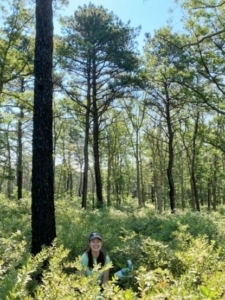
My summer office 🙂
I have been working with the Camp Edwards team for almost three months now and am still constantly in awe of all the different projects that they have in motion. While box turtles are my favorite (duh!), they are only a small part of the work done in the Natural Resources/ Integrated Training Area Management (NR-ITAM) office at Camp Edwards. What are these other projects, you ask? Fear not, I will give you a snapshot of all the other cool things that have been simultaneously happening here on base. Their team consists of six conservation and land management specialists, and the NR-ITAM mission is to “Maintain and enhance training lands and training opportunity through land management, interagency partnerships, environmental planning, and permit coordination.”
Species surveys – There are countless species surveys that take place on base, but these are the ones I have learned the most about during my time here!
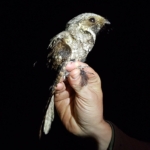
- Eastern Whip-poor-wills (Antrostomus vociferus): These super neat birds are named after their unique calls. I am really not the best at identifying birds in general, but I can now confidently ID a whip-poor-will after hearing these guys from my bedroom window all summer. Since they are nocturnal, surveys for these birds happen in the late evening when they are most active.
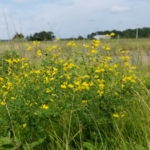
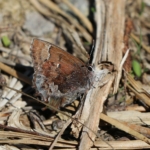
- Frosted Elfin Butterflies (Callophrys irus): This is a species of special concern in Massachusetts. These butterflies depend on wild indigo (Baptisia tinctoria) as their host plant which can be identified by its small yellow flowers. I am still so impressed when the field techs can spot these tiny butterflies after getting a split-second glance as they fly by.
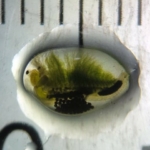 Clam Shrimp: This is the most bizarre species that I have ever seen, and for the longest time I was convinced they did not exist. There are a couple species of clam shrimp on base, and all are tiny, almost microscopic, and live inside puddles. When the puddles are dry, the eggs go dormant until a heavy rainfall. They have a short life cycle (just over a week!), so after it rains, the eggs hatch, become sexually mature, and lay eggs of their own before dying as the puddle dries up. Nicole got a microscope image of one, so now I believe they exist, but kinda think they are aliens?? Nonetheless, these are wonderfully weird and awesome.
Clam Shrimp: This is the most bizarre species that I have ever seen, and for the longest time I was convinced they did not exist. There are a couple species of clam shrimp on base, and all are tiny, almost microscopic, and live inside puddles. When the puddles are dry, the eggs go dormant until a heavy rainfall. They have a short life cycle (just over a week!), so after it rains, the eggs hatch, become sexually mature, and lay eggs of their own before dying as the puddle dries up. Nicole got a microscope image of one, so now I believe they exist, but kinda think they are aliens?? Nonetheless, these are wonderfully weird and awesome.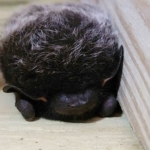 Bats: Several microphones are set up around base for acoustic surveys, and the recordings are analyzed to identify the bats that produce the calls. I have yet to see a bat on base, but this survey method is a genius method of species ID and requires a solid knowledge of call patterns.
Bats: Several microphones are set up around base for acoustic surveys, and the recordings are analyzed to identify the bats that produce the calls. I have yet to see a bat on base, but this survey method is a genius method of species ID and requires a solid knowledge of call patterns.- Eastern Box Turtles: Y’all know the drill for these guys. Tracked with radiotelemetry, found by seasoned field techs, and sampled & photographed by a certain over-enthusiastic vet student. These turtles are the best, but I might be a bit biased…
Habitat management – This is a multifaceted venture that involves several different tactics to remove invasive species, promote native habitats, and create training areas for soldiers.
- Prescribed burns: This is an important tool for managing native habitats and protecting surrounding
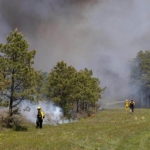 neighborhoods from uncontrolled wildfires. A couple of prescribed burns have taken place since I’ve been here. They require an extensive amount of planning, collaboration, and physical labor. I personally appreciate these burns since they help keep scrub oak and other brush from becoming too dense which helps us on our hikes to find turtles! These burns also help prevent the growth of invasive species that are not accustomed to fire.
neighborhoods from uncontrolled wildfires. A couple of prescribed burns have taken place since I’ve been here. They require an extensive amount of planning, collaboration, and physical labor. I personally appreciate these burns since they help keep scrub oak and other brush from becoming too dense which helps us on our hikes to find turtles! These burns also help prevent the growth of invasive species that are not accustomed to fire. - Invasive species: Prescribed burns significantly help with this, but control of invasive species is also done by mowing and physical removal via cutting. This helps create open grasslands for soldiers to camp on while also promoting growth of native plants for pollinators. I have been pleasantly surprised by all the wild milkweed growing on base! We love sustainable pollinator habitats!!
This is just a taste of everything that is done on base! To learn more about 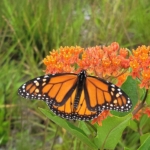 these plus other cool projects, take a look at their website https://www.massnationalguard.org/ERC/index.html! Also, big thank you to my Cape Cod roomie, Nicole Madden, for these awesome photos!
these plus other cool projects, take a look at their website https://www.massnationalguard.org/ERC/index.html! Also, big thank you to my Cape Cod roomie, Nicole Madden, for these awesome photos!
Total Turtle Count = 149
